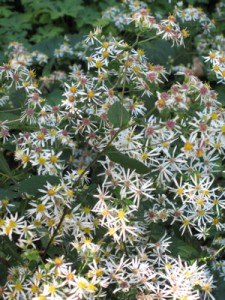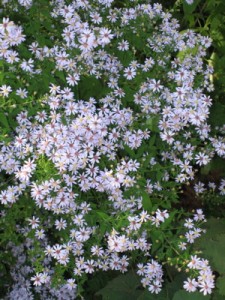August Asters
August 21, 2009 by admin
Filed under Perennials, Summer, Summer Bloomers
We’ve all heard the expression “familiarity breeds contempt.” Well, it’s as true in the garden world as in the great wide world. Some of the best garden plants grow wild all around us and never get the recognition they deserve because they’re, well, common.
Native asters are a case in point. The Northeast is aster country, home to handfuls of species, and they’re so widespread that even a short walk down a country lane in August will probably turn up half a dozen kinds.
Never mind that the taxonomists have been at it again and the genus Aster was recently carved up and parceled out into several new genera including Eurybia and Symphyotrichum. “August Symphyotrichums?” I think not. I say if it walks like a duck and talks like a duck, it’s an aster…or, well, you know what I mean.

White wood aster is as close to a no-care plant as a plant can get, and native to boot
I have a soft spot for asters, especially the delicate roadside kinds, because they start to bloom at just the time of year when it doesn’t seem like anything should be able to look good. “Sticky heat” is a typical mid August weather forecast in this part of the world, and I know those conditions don’t exactly bring out the best in me. In fact, the word that usually springs to mind when I think of August is “awful!” But when I’m feeling like a wrung-out dishrag, asters are just starting to look cool, fresh and flowery.
Two of the best native species have begun to make headway in the gardening world in the last couple of years and are no longer strictly speaking “specialty plants.” Major plant growers are now propagating them, and you should be able to find them or order them at good nurseries.
My favorite native roadside aster is white wood aster (Aster divaricatus, recently rechristened Eurybia divaricata—yuck!). I frequently say that there’s no such thing as a no-care plant, but if forced at gunpoint to name the closest thing, this would be it.
White wood aster is a well-behaved plant, growing only about 24″ tall and completely capable of supporting itself. Its stems are black and its leaves broad, medium green and attractive. It’s been in the vegetative background for several months now, just growing slowly and steadily, but in the past week its flowers have begun to pop, making it more noticeable.
White wood aster is like a black sweater in your wardrobe-it goes with everything. It’s a little too tall to plant at the very forefront of most gardens, but set back a foot of two in your border it will shine no matter what its companions. White wood aster is sometimes offered under the cultivar name ‘Eastern Star’. To be honest, I can’t see any difference between the species and the supposedly improved cultivar, so don’t fret the presence or absence of a cultivar name.

Blue wood aster in all its flowery August glory
The other aster I await with anticipation every year is blue wood aster (Aster cordifolius, recently renamed Symphyotrichum cordifolium—double yuck!). It can grow to four or even five feet in height, and if not staked it will flop over. If grown with enough other tall things around it, it can simply drape itself over them prettily. Possible garden cohorts might include Japanese anemone (Anemone x hybrida), yellow waxbells (Kirengeshoma), toad lily (Tricyrtis), turtlehead (Chelone), snakeroot (Eupatorium rugosum) and northern sea oats (Chasmanthium latifolium).
If you don’t stake it, I’d recommend pinching it early in the season when it reaches a height of two feet or so. You don’t have to get fussy and give it a $100 haircut. One good whack with a pair of hedge clippers, removing up to half the growth, will do the job. “Pinching” it in this way will also delay flowering somewhat, as pinching usually does. You can treat white wood aster the same way if you want it to be shorter or bushier for any reason.
As its name suggests, the flowers of blue wood aster are blue, although personally I’d call their hue more of an icy violet. It’s an interesting color that changes depending on the quality and angle of the light, making the plant something to go out of your way to see at different times of day and in every kind of weather.
Blue wood aster is most frequently offered in a form called ‘Avondale’. It does seem to me that ‘Avondale’ is more floriferous than the straight species, but you can’t go wrong with either one.
White wood aster and blue wood aster share a pair of wonderful traits. First, they aren’t prone to powdery mildew. This common, disfiguring disease afflicts many New England and New York asters, but you’ll see nary a trace of it on the duo I’ve described for you here.
Second, they’ll bloom well even in moderately shady conditions. (Most of the asters traditionally offered in garden centers require full sun to do well.) In fact, I’ve never grown them in anything but some degree of shade, and I’d be curious to get a report on their performance from readers who have used them in full sun. I wouldn’t recommend putting them in deep shade, however. I’m using nature as my guide here-I never see them growing in such a situation in the wild.
So, grant these two lovely native asters the respect they’ve long deserved and give them pride of place in your garden. They’ll give you, too, something to anticipate in “awful” August.

